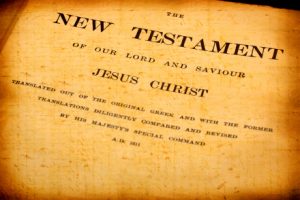This is a quick crash course in textual review of the Gospels and where they came from. Obviously, we all know they came from the Holy Spirit’s inspiration, who inspired human beings in the collecting various of stories and also directly inspiring the writers themselves, whether the writers were direct witnesses or collectors of the information. Despite this inspiration, there still was a massive human cooperation with God that gave us the collection of the Four Gospels. It is important as Christian Counselors, ministers, priests, and chaplains to have a good foundation in what the Gospels are and where they came from.
Preaching the Gospel is a standard phrase for those in ministry but what are the Gospels themselves? Obviously the term to preach the Gospel extends beyond just the teachings found in the Four Gospels but are expounded throughout the entire Bible, but the ideal of the Gospel, the story of Jesus Christ and what He meant for salvation is the core concept found in the Gospels. The previous books prepare the Christian for the encounter with Christ as found in the Gospels, while the Epistles explain them in greater detail.

Hence the message of the Gospel is that Jesus Christ is both God and man and came to Earth to redeem humanity from the sin of Adam. In Christ, everything is made perfect. In Christ, is the perfect sacrifice and bridge to God. Without Christ, no salvation is possible and it is essential to accept Christ via Baptism to apply the blood of His redemption on the cross. This is why it is was so critical a command to preach this message to all corners of the world.
The Gospels hence paint a picture of who Christ is and why He came. They form the cornerstone of Christ’s teaching and set the basis for the Church. It was hence critical for the Church to enshrine them as part of the foundational structures of the faith and all Christian theology. The Four Gospels of Matthew, Mark. Luke and John were all formally written before the end of the 1st century. In fact, most findings dictate that the Epistles of Paul outdate the Gospels. It shows that the ideas of the Gospels had not been written yet by their namesakes, or at least collected together into one volume after the preaching of Paul. Historic and literary criticisms of the text show that Mark was the first book written of the Four Gospels and Mark’s Gospel collected data from various sources. These sources are known as the Que source which had accumulated various stories about the life of Christ handed down verbally and also in some cases documented. Unfortunately, this common source of data about Christ has never been collected but the very fact most Gospels share common stories, illustrates a common source regarding the life of Christ as handed down by the Apostles.
The Gospels were stories of Christ that were collected from eye witness accounts or contain parts written directly as witnessed by the observer. Historical authorship traditionally is applied to the namesakes of the Gospels themselves, the Apostles John and Matthew and the Disciples Mark and Luke. Some contend that these historic figures only are of the name of the book and not the actual author or redactor. Others contend that the eye witnesses themselves wrote the book. Hence in John and Matthew, we see apostles who witnessed the life of Christ. While Mark and Luke would have depended more on eye witness accounts as well as other source materials.
Despite only having only Four Gospels, the Church existed within the first three centuries under persecution and it would not be until the Fourth Century that it was able to canonize the books as inspired. Many other books were classified as uninspired and left out of the canon. Such books as the Gospel of Thomas or the Infancy Narratives were considered non canonical. Some other books were considered heretical while others were considered pious but not inspired.
Hence the Church canonized the New Testament and accepted only the four we see today. The first three are referred to as the Synoptic Gospels, while the Gospel of John stands on its own as a unique Gospel that has a higher Christological value. While all the Gospels show Christ is both God and Man, the Gospel of John emphasizes the Divinity of Christ at a higher level. This differences in emphasis is important to the whole story of Christ.

The Synoptic Gospels while sharing similarities, nonetheless also differ in audience. Matthew’s audience is more towards the Jewish population. Matthew wished to show how Jesus was a good Jew and came not to destroy the Law but to fulfill it, while Luke engages more with the Greek world, showing that Christ has also come to save all of humanity, not just the Jewish people. If these namesakes of these Gospels are indeed the historical individuals, then Matthew would have an indepth knowledge of Christ as well as the Jewish law. Luke who writes much on the infancy of Christ, according to tradition, also knew the Virgin Mary well and is said to have written the first icon of the Mother of God. This would tie to the indepth amount of the infancy stories found in Luke.
Regardless, the Gospels are written and inspired and share their namesakes actual hand or spirit. The accounts compliment and supplement each other. Where others look to find contradictions or minor variations, the Church sees the many stories of Christ and their diversity shared in the Gospels. In fact, as John points out, not even all the books of the world could contain the many stories of Christ. The Church is grateful to possess four accurate accounts that supplement different audiences but share the same inspired story of Christ, God and Man, and also Redeemer for all audiences.
While various criticisms exist for Scripture, they should not be seen as critiques but instead research into the history, literary aim, and textual development to better understand the individual book. These are important tools that if used reverently can be used to help us better appreciate the Word of God and message of salvation.

The stories and accounts are reliable because one can see the full story of Christ find form. While only in oral form for the longest time, they found parchment and permanency through the Holy Spirit and His divinely inspired writers. These same witnesses would later forfeit their lives for the stories found in to cement their authenticity with their own blood.
This is why we believe and this is why we share the Four Gospels.
Please also review AIHCP’s Christian Counseling Certification and see if it matches your academic and professional goals.
